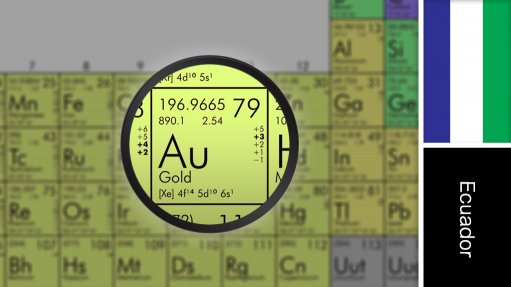
Name of the Project
Cangrejos copper/gold project.
Location
Ecuador.
Project Owner/s
Lumina Gold.
Project Description
The preliminary economic assessment (PEA) envisages large-scale openpit mining using a 100% owner-operated equipment fleet.
Five mining phases have been designed for Cangrejos and two mining phases have been designed for the project’s Gran Bestia deposit, both using a technique that optimises present value using a declining cutoff grade over the mine life.
Payable production is estimated at 366 000 oz/y of gold over the 25-year life-of-mine (LoM). Paybable by-product production over the LoM is estimated at 46-million pounds of copper a year.
Gran Bestia material begins to enter the mine production schedule in Year 5; however, the majority of the Gran Bestia economic mineralisation (88%) is mined in the last nine years of the production schedule.
The proposed processing plant for Cangrejos is a conventional copper/gold flotation concentrator and carbon-in-leach (CIL) circuit designed to treat 40 000 t/d of mineralised material during the first five years of operation and then be expanded to process 80 000 t/d.
Near-surface saprolite and saprock materials have been included in the mill feed, since the material can be processed with the addition of the CIL plant. The saprolite and saprock account for 2% of the LoM processed material and contain 269 000 oz of gold. The CIL circuit throughput will be 4 000 t/d in the first five years and 8 000 t/d after the expansion project in Year 6.
The dry stack tailings facility (DSTF) is proposed to be located in relatively close proximity to the plant site. This will allow for simple access by the overland conveyor from the plant to transport filtered tailings to the edge of the DSTF.
Mobile conveyors and a radial stacking system will then be used to place the tailings, along with using dozers and compactors, to spread and compact the tailings in thin lifts. As lifts are completed, it is planned that they will be progressively closed by grading the outer slopes and covering them with a growth media and revegetating them to reduce erosion and help stabilise the slopes. The facility is expected to contain about 640-million tonnes of tailings, along with having significant future expansion potential.
The waste rock storage facility (WRSF) and saprolite storage facility for the project are proposed to be located in a closed drainage basin south of the openpit and will store about 730-million tonnes of waste rock, saprolite and saprock, according to the mine production schedule. The WRSF is planned to be built in multiple phases, initially from the top down to create the WRSF haul road, and then from the bottom up. Where possible, saprolite and saprock will be stored away from the toe areas of the WRSF and at higher elevations to facilitate capping the facility with growth media. As the facility loading levels rise, lower slopes are expected to be regraded, covered with growth media and revegetated to reduce erosion and help stabilise the slopes.
Potential Job Creation
Not stated.
Net Present Value/Internal Rate of Return
The project has a net present value, at a 5% discount rate, of $2.56-billion and an internal rate of return of 20.2%.
Capital Expenditure
Initial capital costs are estimated at $1-billion.
Capital cost to double throughput, including working capital, is estimated at $454-million.
Planned Start/End Date
Not stated.
Latest Developments
None stated.
Key Contracts, Suppliers and Consultants
MTB Enterprises Inc (PEA) and Ausenco (DSTF).
Contact Details for Project Information
Lumina Gold, tel +1 604 646 1890 or email info@luminagold.com.